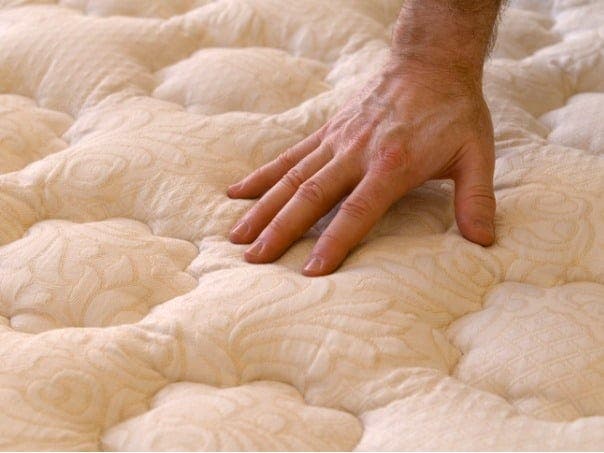Mattresses
Published February 9, 2022
14 minMattress Firmness Scale: A Complete Guide to Finding Your Perfect Mattress Comfort
At Nectar Sleep, we believe that the right mattress is about more than getting a good night's rest – because proper sleep makes your days better, too. And when it comes to choosing your perfect mattre

Table of contents
Understanding the Mattress Firmness ScaleWhy Mattress Firmness MattersThe Science of Firmness and SupportMatching Firmness to Your Sleeping PositionHow Body Weight Affects Ideal Mattress FirmnessBeyond the Number: What Creates Firmness in a MattressFirmness and Temperature: An Often Overlooked ConnectionSigns Your Mattress Firmness Isn't RightTesting Mattress Firmness: The 30-Second CheckNectar's Approach to Mattress FirmnessBreaking In Your Mattress: Firmness Changes Over TimeFinal Thoughts: Firmness is PersonalFrequently Asked Questions
At Nectar Sleep, we believe that the right mattress is about more than getting a good night's rest – because proper sleep makes your days better, too. And when it comes to choosing your perfect mattress ? Understanding firmness is absolutely essential.But here's the thing: firmness isn't a one-size-fits-all concept. What feels heavenly to one person might feel like sleeping on a cloud (too soft!) or a concrete slab (too firm!) to another. That's why we've created this comprehensive guide. Let’s navigate the often confusing world of mattress firmness.
Understanding the Mattress Firmness Scale
Let's start with the basics. The mattress firmness scale typically ranges from 1 to 10, with 1 being the softest and 10 being the firmest. Here's a quick breakdown:- 1-3: Soft - You'll sink right in, like sleeping on a fluffy cloud
- 4-6: Medium - The sweet spot for many sleepers, offering a balance of softness and support
- 7-9: Firm - Minimal sinking with solid support underneath
- 10: Extra firm - Maximum support with very little give
Why Mattress Firmness Matters
The firmness of a mattress directly impacts two crucial aspects of sleep quality:- Comfort: This is subjective and relates to personal preference—some people simply prefer the feeling of sinking into a softer surface, while others enjoy the stable feeling of firmer mattresses.
- Support: This is more objective and refers to how well a mattress keeps your spine properly aligned. But don't make the common mistake of equating firmness with support – even softer mattresses can offer excellent support, if they’re constructed properly.
The Science of Firmness and Support
When you lie down on a mattress, your body creates different pressure points based on weight distribution. Areas like shoulders and hips typically exert more pressure than others. A good mattress—regardless of its firmness level—should distribute this pressure evenly, allowing for:- Proper spinal alignment from head to toe
- Reduced pressure on joints and sensitive areas
- Adequate support for your body’s natural curves
- Even weight distribution across the mattress surface
Matching Firmness to Your Sleeping Position
Your preferred sleeping position plays a significant role in determining your ideal firmness level:Side Sleepers
If you're among the roughly 70% of people who sleep on their side, you'll typically benefit from soft to medium firm mattresses. Why? In this position, your shoulders and hips bear the brunt of your body weight, creating pressure points. Softer mattresses with plush comfort layers allow these wider parts of your body to sink in just enough to maintain proper spinal alignment while providing pressure relief for those sensitive areas.Side sleepers who experience shoulder or hip pain on firmer surfaces should consider mattresses with enhanced pressure relief, such as those with memory foam or pillow-top comfort layers. The key is finding a surface that cradles these pressure points without allowing too much sinkage.Back Sleepers
Back sleepers tend to fare best with mattresses in the medium to medium-firm range. This firmness range supports the natural curve of your lower back while preventing your hips from sinking too deeply, which could throw your spine out of alignment. The goal is to find a mattress that keeps your lower back support while still contouring to your body's natural curves.For back sleepers, proper lumbar support is especially important. The right firmness level will fill the space between the mattress and your lower back, supporting the natural curvature of your spine. Without this support, you’re likely to wake up with lower back pain or stiffness.Stomach Sleepers
If you primarily sleep on your stomach, firmer mattresses are typically your best bet. Stomach sleeping can place strain on your neck and lower back, and softer mattresses might allow your midsection to sink too deeply, leading to eventual back pain. A firmer surface helps keep your spine in a more neutral position.Stomach sleepers with particularly sensitive shoulders or who experience pressure point pain may want to consider a mattress with a slightly softer top layer but a firm supportive core. This combination provides the necessary support while still offering some cushioning comfort.Combination Sleepers
Many of us switch positions throughout the night. If that sounds like you, a medium firm mattress often provides the versatility needed to accommodate different sleeping positions.Combination sleepers should also consider mattress responsiveness—how quickly it adjusts as you change positions. Memory foam, while excellent for pressure relief, can sometimes create a "stuck" feeling that makes repositioning difficult. Hybrid mattresses often offer a good balance of contouring and responsiveness for those who move around during the night.How Body Weight Affects Ideal Mattress Firmness
Your body weight significantly impacts how you experience mattress firmness:Lighter Individuals (Under 130 lbs)
If you're on the lighter side, you may find that firmer mattresses feel uncomfortably hard because you don't sink in enough to engage the comfort layers. You'll typically want to choose a mattress that's slightly softer than the general recommendation for your sleeping position.Lighter sleepers may benefit from mattresses with plush euro or pillow tops, or additional cushioning in the upper comfort layers. These features allow lighter bodies to experience the pressure-relieving benefits that heavier sleepers might feel on firmer surfaces.Average Weight (130-230 lbs)
Most mattress firmness recommendations are based on this weight range. If you fall within these parameters, the standard suggestions for your sleeping position should work well for you.That said, personal preference still plays a major role. Within the average weight category, some sleepers naturally prefer a softer feel while others enjoy more firmness. Don't be afraid to trust your comfort instincts even if they deviate slightly from the recommendations.Heavier Individuals (Over 230 lbs)
If you carry more weight, you'll likely sink deeper into any mattress. You may want to choose a mattress that's slightly firmer than the general recommendation for your sleeping position to ensure adequate support. Additionally, look for mattresses with enhanced support systems, such as those found in many of our hybrid mattresses that combine foam comfort with supportive coil systems.Heavier sleepers should also pay attention to mattress thickness. A mattress that's at least 12 inches thick typically provides better durability and support for higher body weights. The extra depth allows for adequate comfort layers while still maintaining the necessary underlying support.Beyond the Number: What Creates Firmness in a Mattress
Mattress firmness doesn't just come from one factor—it's created through a combination of:- Comfort Layers: The top layers of the mattress that provide immediate cushioning
- Transition Layers: The middle sections that determine how deeply you sink
- Support Core: The foundation that provides overall stability and durability
- Memory foam typically creates a softer, more contouring feel that's excellent for pressure relief
- Latex foam offers a responsive, slightly firmer feel with natural bounce
- Gel-infused foams provide the pressure relief of traditional foams while helping to regulate temperature
- Coil systems, such as those found in hybrid mattresses generally create a more responsive, supportive feel
Firmness and Temperature: An Often Overlooked Connection
An interesting aspect of mattress firmness that's rarely discussed is how it can affect sleep temperature. Generally, softer mattresses allow you to sink in more, which can restrict airflow around your body and potentially lead to warmer sleep. Firmer mattresses, with less sinkage, often allow for better airflow and cooler sleeping conditions.However, modern mattress materials have largely addressed this concern. Nectar’s mattresses incorporate cooling technologies like cooling fibers woven into the surface, phase change technology, and breathable cover materials to ensure comfortable temperature regulation regardless of your preferred firmness level.Signs Your Mattress Firmness Isn't Right
How do you know if your mattress firmness isn't working for you? Watch for these signs:- Waking up with pain or stiffness, particularly in your lower back, neck, or shoulders
- Tossing and turning throughout the night, or struggling to get comfortable
- Feeling like you're sinking too deeply or not sinking in at all
- Numbness or tingling in your limbs upon waking
- Not feeling refreshed after a full night's sleep
- Sleeping better in other beds (like hotel mattresses or a friend's guest room)
- Having to use multiple pillows to compensate for lack of support or comfort
Testing Mattress Firmness: The 30-Second Check
Here's a quick test you can perform to check if your current mattress firmness is working for you:- Lie in your typical sleeping position
- Have someone take a photo of you from the side (use a self timer or mirror if alone)
- Check your spinal alignment:Side sleepers: Your spine should form a straight horizontal line
- Back/stomach sleepers: Your body should maintain its natural S-curve without excessive sinking at the hips












